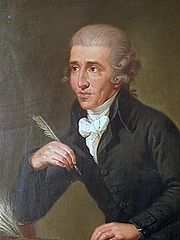Haydn Year 2009

In 2009 the music world around the globe will commemorate the 200th anniversary of the passing of Joseph Haydn (1732-1809), one of the most prominent composers of the classical period. Born in Rohrau (Lower Austria), Haydn became Kapellmeister to the Esterházy family, residing from 1766 to 1790 in Eisenstadt (in present-day Burgenland). He won renown as Europe’s most famous composer during his later years. He was a universal musical genius having composed operas, 107 symphonies, 69 string quartets, 128 baryton trios and 14 masses and is often referred to as the “Father of the Symphony” and “Father of the String Quartet.” As birth place and home of Joseph Haydn, Austria will host several series of exquisite concerts, exhibitions and other cultural highlights featuring renowned conductors Nikolaus Harnoncourt, Christophe Rousset, Adam Fischer, Sir Colin Davis, and others, performing with outstanding orchestras. Major events will take place in Eisenstadt and Vienna.
What Salzburg is to Mozart, Eisenstadt is to Joseph Haydn. No single place holds so much historical significance for a composer as Eisenstadt does for Joseph Haydn. Specifically, Esterházy Castle in Eisenstadt is the center of Haydn’s world and site where many of his works were originally performed when starting in 1761 in the service of the Esterházy family for more than three decades as musical director, remaining involved with the royal court. Eisenstadt will honor Haydn with a main exhibition entitled, “The Haydn Phenomenon” which includes four intertwined venues: Esterházy Castle hosts the focal point of courtly music; the Haydn House Museum in the artist’s former domicile displays testimonials of his private life and work from valuable originals such as handwritten compositions, letters and original instruments and other historical artifacts; the Museum of the Diocese highlights church music at the princely court, and the Burgenland State Museum looks at how Haydn wandered between the worlds of folk art and high culture.
Events in Vienna include an exhibition at the Austrian National Library, which traces important stages in Haydn’s work - his stays in London (1790 to 1792 and 1794 to 1795), the great masses as well as the original autograph composition of the Imperial Anthem, “God Save The Emperor,” which Haydn created to raise patriotic awareness during the Napoleonic Wars. Haydn, who had started his career as Choir Boy in Vienna’s St. Stephen’s Cathedral, returned to the city after working for the Princes Esterházy and spent his final years in Vienna. The newly refurbished Haydn House in Vienna has been recently opened. For more information, visit : hayndyear2009.at
